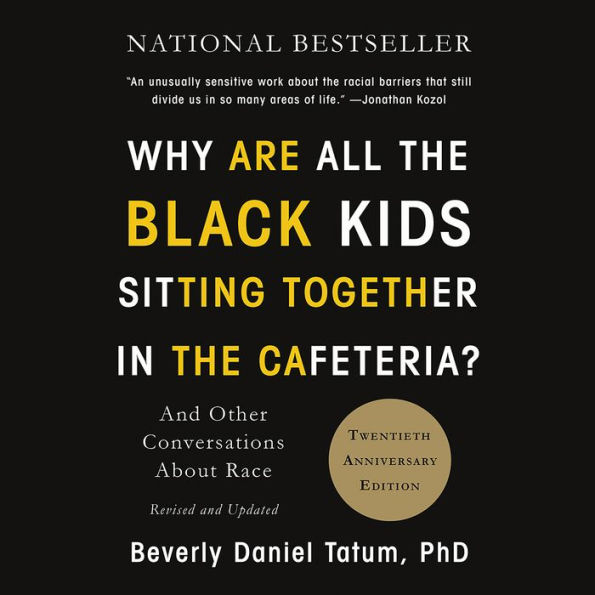A commonsense manual on understanding some of the social dynamic at work in society.

Why Are All the Black Kids Sitting Together in the Cafeteria?: And Other Conversations about Race
Narrated by Beverly Daniel Tatum
Beverly Daniel TatumUnabridged — 13 hours, 27 minutes

Why Are All the Black Kids Sitting Together in the Cafeteria?: And Other Conversations about Race
Narrated by Beverly Daniel Tatum
Beverly Daniel TatumUnabridged — 13 hours, 27 minutes
Audiobook (Digital)
Free with a B&N Audiobooks Subscription | Cancel Anytime
Already Subscribed?
Sign in to Your BN.com Account
Related collections and offers
FREE
with a B&N Audiobooks Subscription
Overview
Walk into any racially mixed high school and you will see Black, White, and Latino youth clustered in their own groups. Is this self-segregation a problem to address or a coping strategy? Beverly Daniel Tatum, a renowned authority on the psychology of racism, argues that straight talk about our racial identities is essential if we are serious about enabling communication across racial and ethnic divides. These topics have only become more urgent as the national conversation about race is increasingly acrimonious. This fully revised edition is essential listening for anyone seeking to understand the dynamics of race in America.

Editorial Reviews
A remarkably jargon-free book that is as rigorously analytical as it is refreshingly practical and drives its points home with a range of telling anecdotes.
A comprehensive recipe for how one can become an 'anti-racist.'
A clinical psychologist and professor at Mount Holyoke College, Tatum (who is black) brings some worthwhile perspectivesdevelopmental psychology and racial identity development theoryto issues of race. Thus, she observes that, when asked for self-definition, whites take their race for granted, while students of color do not. She notes that adults don't know how to respond when children make race-related observations, such as confusing dark skin with dirt. Answering the book's title question, she explains that black students, in late adolescence and early adulthood, are first grappling with "what it means to be a group targeted by racism," and thus seek solidarity in an "oppositional identity." Such solidarity often remains necessary, even in corporate settings. She observes credibly in her chapter on affirmative action that the "less-qualified" person is usually seen as black, not a white woman, and suggests that whites are more likely to favor their own in cases when the minority applicant is equally qualified. However, she argues that only poorly implemented affirmative action programs promote the unqualified; her treatment of this issue is too pat, as is her treatment of affirmative action in academic admissions. Tatum recommends all-white support groups to work through feelings of guilt and shame regarding racism. She also calls for more dialogue about race; such dialogue, however, would likely have to include such touchy subjects as questions of race and crime in order to be fruitful. Author tour. (Sept.)
YASituations perceived as a social segregation are frequently observed at the middle school, high school, and university levels. Here, a look at the school scene leads into a deeper study of racial relations. With a combination of anecdotal material, anthropological data, and psychological insight, Tatum examines the development of racial identity. In balanced sections, she considers understanding blackness in a white context and the development of a white identity itself. There is also an examination of critical issues in Latino, American Indian, and Asian-Pacific American identity development. About a fifth of the book consists of resources, notes, and annotated bibliographies that include videos. All materials are current. A list of multicultural books for children is grade differentiated. Tatum advocates affirmation of whatever race one may be, recognition of injustice, and resolution to resist unfair privilege.Frances Reiher, Fairfax County Public Library, VA
"We don't talk about race in America, but we must start if we are going to heal this broken country—and Beverly Tatum's book is exactly the conversation opener we should be using."—Jodi Picoult, #1 New York Times bestselling author of Small Great Things
"Why Are All the Black Kids Sitting Together in the Cafeteria? is an unusually sensitive work about the racial barriers that still divide us in so many areas of life. This is a valuable book by a fine psychologist who knows how to listen to young people."—Jonathan Kozol, author of Amazing Grace
"Why Are All the Black Kids Sitting Together in the Cafeteria was a landmark publication when it appeared in 1997. Twenty years later this updated edition is as fresh, poignant and timely as ever."—Earl Lewis, President, the Andrew W. Mellon Foundation
“This book should be required reading for every American.”—Kathleen McCartney, president, Smith College
“We read the original version of this book twenty years ago and learned a great deal about race, racism, and human behavior. This updated version provides even more insights about the racial, ethnic, and cultural challenges we face in American society, and particularly in higher education.”—Freeman A. Hrabowski III, president, University of Maryland, Baltimore County
“Just as this experienced psychologist and wise educational leader reminds us here that we cannot talk meaningfully about racial identity without talking about racism, so too must we learn from her words about how to talk and teach and dialogue across those boundaries, in the hopes of better realizing the potential of our diverse democracy.”—Nancy Cantor, chancellor, Rutgers University-Newark
“Beverly Daniel Tatum shows great depth and sensitivity in this thoughtfully enlightened book about the subtleties of racial interactions in America.”—Alvin F. Poussaint, M.D., Harvard Medical School
“A commonsense manual on understanding some of the social dynamics at work in society.”—Milwaukee Journal Sentinel
“A comprehensive recipe for how one can become an ‘anti-racist.’”——Build Magazine
“A remarkably jargon-free book that is as rigorously analytical as it is refreshingly practical and drives its points home with a range of telling anecdotes.”—Kirkus Reviews
Product Details
| BN ID: | 2940173411525 |
|---|---|
| Publisher: | Hachette Audio |
| Publication date: | 09/05/2017 |
| Edition description: | Unabridged |
| Sales rank: | 793,737 |
Videos


